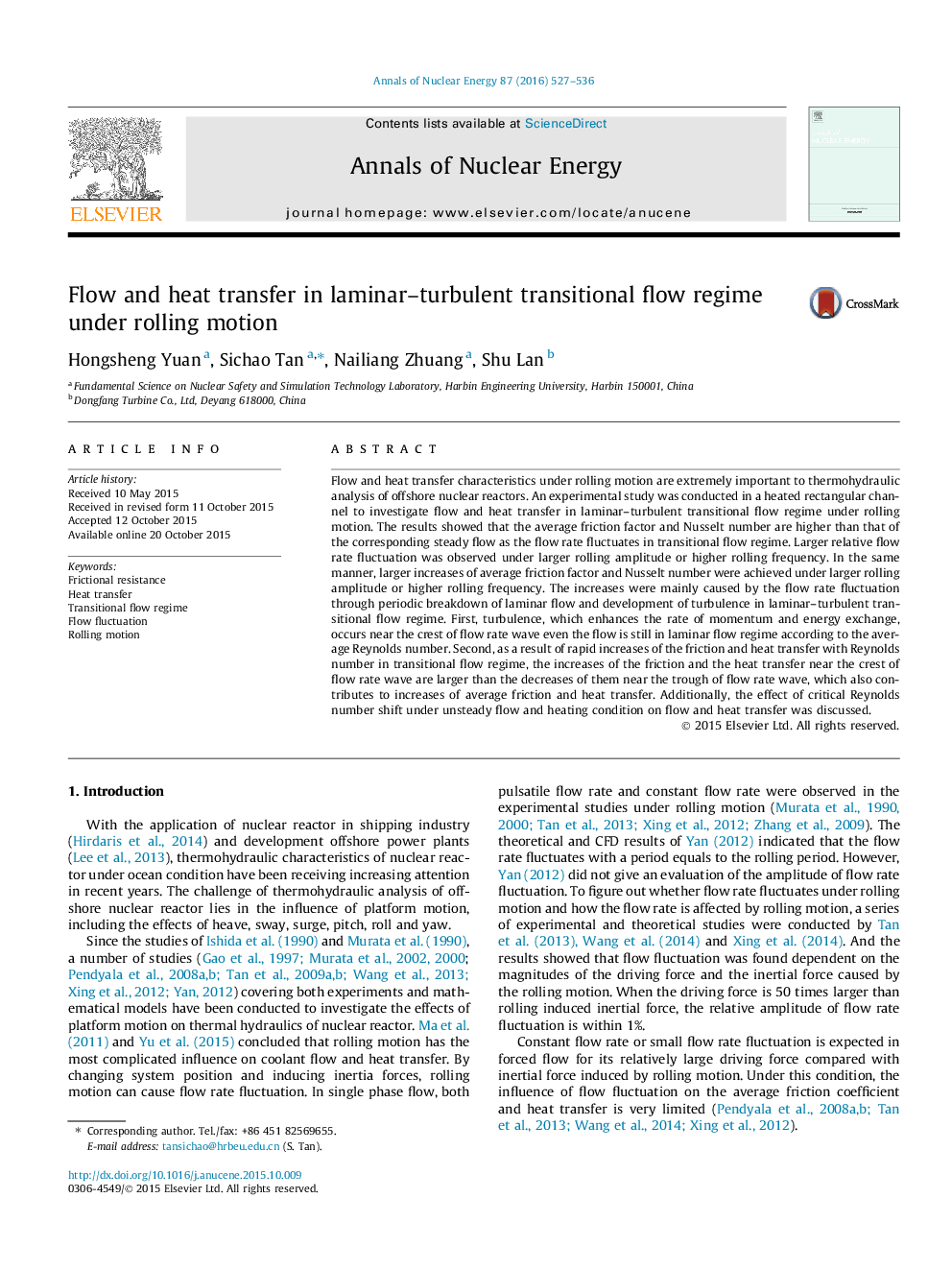| کد مقاله | کد نشریه | سال انتشار | مقاله انگلیسی | نسخه تمام متن |
|---|---|---|---|---|
| 8068126 | 1521110 | 2016 | 10 صفحه PDF | دانلود رایگان |
عنوان انگلیسی مقاله ISI
Flow and heat transfer in laminar-turbulent transitional flow regime under rolling motion
ترجمه فارسی عنوان
جریان و انتقال گرما در رگ جریان جابجایی لنگار - آشفته در حرکت نورد
دانلود مقاله + سفارش ترجمه
دانلود مقاله ISI انگلیسی
رایگان برای ایرانیان
کلمات کلیدی
مقاومت اصطکاک، انتقال گرما، رژیم جریان گذار نوسان جریان حرکت نورد
ترجمه چکیده
خصوصیات جریان و انتقال حرارت تحت حرکت نورد بسیار مهم است برای تجزیه و تحلیل ترمو هیدرولیک راکتورهای هسته ای در دریای خزر. یک مطالعه تجربی در یک کانال گرم مستطیلی برای بررسی انتقال جریان و گرما در رگ جریان جابجایی لنگار با آشفتگی تحت حرکت نورد انجام شد. نتایج نشان داد که میانگین اصطکاک اصطکاک و تعداد نوستل نسبت به جریان ثابت متناظر بیشتر است، به طوری که سرعت جریان در رژیم جریان انتقالی تغییر می کند. نوسانات سرعت جریان نسبی بزرگتر تحت دامنه نورد بزرگتر یا فرکانس نورد بالاتر دیده شد. به همین ترتیب، افزایش بیشتر فاکتورهای اصطکاک و تعداد نوستل تحت دامنه نورد بزرگتر یا فرکانس نورد بالاتر به دست آمد. این افزایش ها عمدتا بوسیله نوسانات جریان جریان از طریق تجزیه فیزیکی جریان لمینار و ایجاد آشفتگی در رگ جریان جابجایی لرزان است. در ابتدا، آشفتگی، که میزان سرعت حرکت و انرژی را افزایش می دهد، در نزدیکی کراس از موج جریان جریان اتفاق می افتد، حتی جریان هنوز در رژیم جریان انعطاف پذیر با توجه به میانگین تعداد رینولدز است. دوم، به علت افزایش سریع اصطکاک و انتقال حرارت با تعداد رینولدز در رژیم جریان انتقالی، افزایش اصطکاک و انتقال حرارت در نزدیکی کراس از موج جریان بزرگتر از کاهش آنها در نزدیکی جریان جریان است موج سرعت، که همچنین به افزایش متوسط اصطکاک و انتقال حرارت کمک می کند. علاوه بر این، اثر تغییر تعداد انتقادی رینولدز در شرایط جریان و گرما ناپایدار بر جریان و انتقال حرارت مورد بحث قرار گرفت.
موضوعات مرتبط
مهندسی و علوم پایه
مهندسی انرژی
مهندسی انرژی و فناوری های برق
چکیده انگلیسی
Flow and heat transfer characteristics under rolling motion are extremely important to thermohydraulic analysis of offshore nuclear reactors. An experimental study was conducted in a heated rectangular channel to investigate flow and heat transfer in laminar-turbulent transitional flow regime under rolling motion. The results showed that the average friction factor and Nusselt number are higher than that of the corresponding steady flow as the flow rate fluctuates in transitional flow regime. Larger relative flow rate fluctuation was observed under larger rolling amplitude or higher rolling frequency. In the same manner, larger increases of average friction factor and Nusselt number were achieved under larger rolling amplitude or higher rolling frequency. The increases were mainly caused by the flow rate fluctuation through periodic breakdown of laminar flow and development of turbulence in laminar-turbulent transitional flow regime. First, turbulence, which enhances the rate of momentum and energy exchange, occurs near the crest of flow rate wave even the flow is still in laminar flow regime according to the average Reynolds number. Second, as a result of rapid increases of the friction and heat transfer with Reynolds number in transitional flow regime, the increases of the friction and the heat transfer near the crest of flow rate wave are larger than the decreases of them near the trough of flow rate wave, which also contributes to increases of average friction and heat transfer. Additionally, the effect of critical Reynolds number shift under unsteady flow and heating condition on flow and heat transfer was discussed.
ناشر
Database: Elsevier - ScienceDirect (ساینس دایرکت)
Journal: Annals of Nuclear Energy - Volume 87, Part 2, January 2016, Pages 527-536
Journal: Annals of Nuclear Energy - Volume 87, Part 2, January 2016, Pages 527-536
نویسندگان
Hongsheng Yuan, Sichao Tan, Nailiang Zhuang, Shu Lan,
